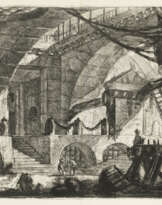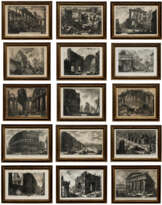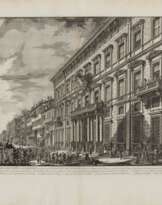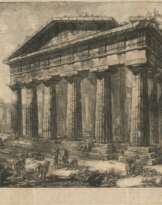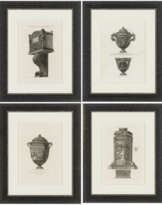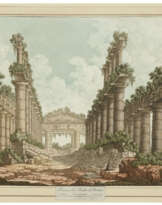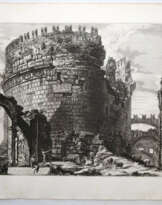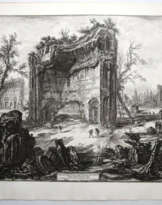ID 993379
Lot 173 | PIRANESI, Giovanni Battista (1720-1778)
Estimate value
£ 20 000 – 30 000
Antichità d'Albano e di Castel Gandolfo. Rome: 1764. [Bound with:] G.B. PIRANESI. Descrizione e disegno dell'Emissario del Lago Albano. [Rome: 1762]. [And:] G.B. PIRANESI. Di due spelonche ornate dagli antichi alla riva del Lago Albano. [Rome: 1762].
A magnificent copy showing Piranesi’s etchings (including some of his ‘most dramatic vedute’ - Wilton-Ely) in fine, fresh impressions, in a grand, contemporary binding, from the Russian Imperial Library at Tsarskoe Selo. Piranesi became fascinated with Lake Albano and here celebrates the monumental feat of ancient Roman engineering that it represented. At the end of the 4th century BCE, following an oracle predicting victory at Veii, the Romans lowered the level of the lake by boring a tunnel beneath what became Castel Gandolfo, the papal summer residence. Piranesi documents the ingenious construction with technical as well as dramatic depictions. In his researches into the tunnel, Piranesi came across two grottoes by the shore, which he depicts in Di due spelonche. Pope Clement XIII encouraged Piranesi to continue his investigation of the area surrounding Castel Gandolfo, and financially supported the publication of Antichità d'Albano e di Castel Gandolfo, which Piranesi dedicated to him. These three work, conceived in ‘support of his passionate belief in Roman originality (Wilton-Ely p.668), are often found bound together, indeed Focillon treats the third work as an appendix to the second.
It is possible that this volume was acquired for Catherine the Great at Rome by her agent I.I. Shuvlov and sent to Russia with 11 other Piranesis before 1769, to join her rich architectural library at Tsarksoe Selo. Catherine took a keen interest in Piranesi, and his aesthetic strongly influenced her choice of ornamentation there (see A. Kruglov, ‘Catherine II, Giacomo Quarenghi, and the Creation of a “Ruin”: the Kitchen-Ruin in the Park of Tsarskoe Selo’). It is bound by a Roman shop specialising in deluxe work for grand clients and recipients, and other 18th-century architectural books at Tsarksoe Selo were bound there, such as the set of volumes published by Rossi (Kissner sale, Christie’s, 1990, lot 447). Other volumes of Piranesi bound by the shop were owned by Landgraf Friedrich II of Hesse-Kassel (see 1994 Sotheby’s sale catalogue for details). This volume may have formed part of a 20-volume set (described as presented by the Pope to the Russian Imperial court) offered at auction by Gilhofer & Ranschburg, Lucerne, 20-21 June 1933, as lot 437. The binding of one volume in the set reproduced there is almost but not exactly identical with the present volume. A 32-volume set bound identically with the Gilhofer set had been offered the previous year, also by Gilhofer und Ranschburg, Lucerne, 14-15 June 1932, lot 359; there are discrepancies between the volume contents of the two sets, which confirms that they are indeed different sets. Focillon pp.315-318; Hind pp.85-86. Wilton-Ely 638-669, 613-24, 625-37.
3 works in one volume, folio (555 x 404mm). I: Letterpress half-title, etched title, double-page dedication to Pope Clement XIII, 26 etched plates (one folding, 11 double-page), one initial and one head-piece. Without the plate on the raised portion of the Appian Way (Wilton-Ely 670) which was added sometime after 1769. II: Etched title, 9 etched plates (one folding, 7 double-page), one initial and one tail-piece. III: 12 etched plates (one folding, 5 double-page), and one head-piece. Watermarks of fleur-de-lis in double circle surmounted by ‘B’ (Robison in Wilton-Ely nos. 33-40). (Half-title to first work with two small spots and one tiny hole.) Contemporary Roman binding of mottled calf richly tooled in gilt with basket-work, shells, and fleurons and other tools, large cinquefoil in spine compartments, red morocco spine label, pastepaper endleaves, edges gilt and line-gauffered, free endpaper at each end with watermark similar to Robinson 46 (only slightly rubbed at extremities). Provenance: Russian Imperial library at Tsarskoe Selo (stamp on half-title; see above) – [possibly Gilhofer & Ranschburg, Lucerne, 20-21 June 1933, part of lot 437] – sold Sotheby’s, Old Master Prints, 1-2 December 1994, lot 115.
| Artist: | Giovanni Battista Piranesi (1720 - 1778) |
|---|---|
| Place of origin: | Italy, Europe |
| Auction house category: | Printed books |
| Artist: | Giovanni Battista Piranesi (1720 - 1778) |
|---|---|
| Place of origin: | Italy, Europe |
| Auction house category: | Printed books |
| Address of auction |
CHRISTIE'S 8 King Street, St. James's SW1Y 6QT London United Kingdom | |
|---|---|---|
| Preview |
| |
| Phone | +44 (0)20 7839 9060 | |
| Buyer Premium | see on Website | |
| Conditions of purchase | Conditions of purchase |





